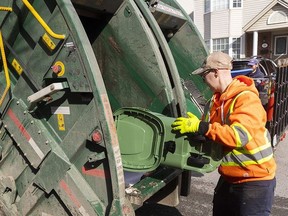Three months after London rolled out its new green-bin program to households, little more than half are using the containers to divert kitchen waste from the city’s landfill.

Three months after London rolled out its new green-bin program to households, little more than half are using the containers to divert kitchen waste from the city’s landfill. While that would barely be a passing grade on a report card, city hall’s waste boss says the early take-up is about what was expected. The Free Press caught up with Jay Stanford on how the program is going after its first quarter and what’s ahead.
Advertisement 2
Article content
Article content
Who’s using the bins – and who isn’t?
According to Stanford, roughly 55 per cent of eligible households with curbside garbage pickup are using their new green bins to dispose of waste that can be composted. That varies from neighborhood to neighborhood, based on anecdotes from collection drivers, with some areas using the bins more but others less. About 126,000 bins were distributed.
While the participation rate might seem startlingly low for a program that came with $15 million in start-up costs, and which will cost the city $4 million a year to operate, Stanford said the progress aligns with city expectations based on how such programs have gone over in other cities. The uptake so far doesn’t account for Londoners who may be doing their own composting.
Advertisement 3
Article content
“In the early going we were seeing about 40 per cent of Londoners involved in the program, and we were actually quite pleased with the initial start and we knew that would grow,” he said. “We know from very mature green-bin programs that have been operating for 10 years. . . participation is 70 per cent, and in some of the better ones, about 75 per cent.
“So, when we look at our trajectory that way, I think Londoners are doing a really good job, because we’re just heading in such a positive direction compared to others after what is, really, only a short period of time.”
Any surprises so far?
The early increase in uptake after the program’s roll-out was likely due to the milder winter weather, Stanford said. One brief hiccup came early on when a winter storm both froze shut some bin latches and froze their contents to the bins.
Advertisement 4
Article content
Stanford said the city regularly checks in with its green-bin processing contractor, Convertus, which so far has reported few issues from either material that should not be discarded in the bins or the volume of waste collected.
Aimed at directing waste away from London’s nearly full landfill, the program’s goal is to divert 20,000 tonnes of material a year. In the first three months, the city is averaging 2.2 tons of green bin material in each truck on collection days and has, overall, entertained about 2,800 tons so far, Stanford said.
With summer coming, Stanford said he hopes Londoners who haven’t yet got into the green-bin habit will consider it to prevent food waste from stewing in the hot weather between the weekly collections.
Advertisement 5
Article content
Recommended from Editorial
What about animals?
While Londoners already have reported some issues with pests, including squirrels chewing through their bins, Stanford said there’s no conclusive evidence of any uptick in problems from animals going after the contents. He recommends tried and true methods to keep critters out of your trash.
“I don’t think anyone has a perfect solution for a crafty raccoon,” Stanford has previously said.
Still, with warmer weather expected to cook the green-bin contents, attracting more pests and insects, he encourages residents to be prepared and to follow city instructions for properly using the containers. Those tips include making sure the bin latches are closed and not putting the bins out before 6 pm the day before a collection.
Advertisement 6
Article content
What’s the bin barcode for?
By now, you might have wondered what the numbers and barcode on your bin are for. It’s a kind of inventory-control system, how the city knows a bin was delivered to your address.
What’s next?
In coming weeks, the city will roll out a pilot program to expand compost collection to tenants of 10 multi-unit buildings, at least four of which have already been selected. The city approved $500,000 in 2020 to get things rolling and, in the city’s latest four-year budget cycle, a total of $4.7 million in operating and capital costs to expand the program to other multi-unit complexes, such as condo and apartment buildings served by city curbside waste collection.
Once the full program takes off, the city will use the money to buy special bins for buildings and acquire two new collection trucks.
“Part of the pilot project will really be to understand the behaviors and what works for tenants who live inside these buildings,” Stanford said. “It’s often going to be based on spaces available: Does that cart get stored indoors and then rolled out on collection day, or is it always going to be outside?
“These are all the things that would be very, very site-specific.”
Article content

